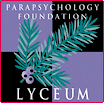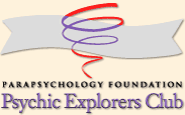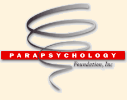 |
 |
| Rhine’s Parapsychology Laboratory was very influential in the modern history of the field, and particularly for the period between the 1930s and 1960. In addition there was the continuing work of organizations such as the above mentioned SPR, and the Institut Métapsychique International. Other influential institutions were the American Society for Psychical Research , the Institut für Grenzgebiete der Psychologie und Psychohygiene, and the Associazione Italiana Scientifica di Metapsichica . The Parapsychology Foundation, founded in 1951 in New York by medium and entrepeneur Eileen J. Garrett (1893-1970), held a unique place in the modern history of the field, providing much needed financial support to research workers and organizations, and sponsoring many conferences, such as the influential one at Utrecht. (For further information click here and here). In 1957 the Parapsychological Association was founded. This organization has been holding annual conventions since 1958, where some of the best research in the world is presented. (For a list of conventions click here.) A list of current organizations and research units is available on-line at the SPR Research Directory. Modern parapsychology has followed Rhine’s lead. A good proportion of the research conducted from the 1950s to our days is focused on laboratory experiments (click here and here. These studies, however, are no longer conducted using cards or dice. Instead the emphasis now is on free-response tests where the person in an ESP study can say whatever comes to her mind and her mentation in compared to video images being viewed by someone else at a distance. This emphasis on free-response was related to interest in altered states of consciousness, which led to attempts to relate ESP to meditation, hypnosis, dreams and states produced by partial sensory deprivation. (For an overview click here). Early interest in these topics culminates in the adaptation development of the Ganzfeld technique for ESP testing. Interest in this technique continues to date and has generated many controversies. The development of modern technology also affected experimental research. The development of random event generators was very useful to the development of experimental psychokinesis studies as well as to generate ESP targets. Similarly, computer technology not only allows for efficient statistical analyses of data, but allows for the automatization of experiments. In addition to the ganzfeld (for example, click here), other experimental lines of research include studies of direct mental influence on living targets . However, there have also been important developments in other areas of research. Work on spontaneous phenomena has included several phenomena. This includes William G. Roll’s work with poltergeists, Ian Stevenson’s work with children who claim to remember previous lives, and Bruce Greyson’s work with near-death experiences. A sample of recent methods and topics of research appear in the program of a recent convention. All of the above are only some highlights of modern developments in parapsychology. Interested readers should consult the PF Bibliographies for information of modern developments. A future blog will be devoted to important developments in the last few decades. |
 |

|
 www. parapsychology. org |
||